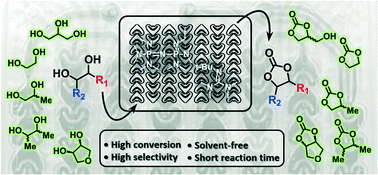当前位置:
X-MOL 学术
›
React. Chem. Eng.
›
论文详情
Our official English website, www.x-mol.net, welcomes your
feedback! (Note: you will need to create a separate account there.)
Solvent-free organocatalytic preparation of cyclic organic carbonates under scalable continuous flow conditions†
Reaction Chemistry & Engineering ( IF 3.4 ) Pub Date : 2018-10-24 00:00:00 , DOI: 10.1039/c8re00209f Zhiguo Wang 1, 2, 3, 4, 5 , Romaric Gérardy 1, 2, 3, 4, 5 , Guillaume Gauron 6, 7, 8, 9 , Christian Damblon 2, 3, 4, 5, 10 , Jean-Christophe M. Monbaliu 1, 2, 3, 4, 5
Reaction Chemistry & Engineering ( IF 3.4 ) Pub Date : 2018-10-24 00:00:00 , DOI: 10.1039/c8re00209f Zhiguo Wang 1, 2, 3, 4, 5 , Romaric Gérardy 1, 2, 3, 4, 5 , Guillaume Gauron 6, 7, 8, 9 , Christian Damblon 2, 3, 4, 5, 10 , Jean-Christophe M. Monbaliu 1, 2, 3, 4, 5
Affiliation

|
A solvent-free organocatalyzed process for the transesterification of dimethyl carbonate (DMC) with 1,2-diols under scalable continuous flow conditions is presented. Process parameters, such as temperature, residence time, DMC/glycerol molar ratio and catalyst loading are optimized for the carbonation of bio-based glycerol using 1,8-diazabicyclo(5.4.0)undec-7-ene (DBU) as a model organocatalyst. The catalytic performance of DBU is next compared with other homogeneous organic superbases including the proton sponge, Verkade's base, guanidines and phosphazenes. 2-tert-Butyl-1,1,3,3-tetramethylguanidine (Barton's base) stands as the most efficient organocatalyst, providing glycerol carbonate at 87% selectivity and 94% conversion within 2 minutes of residence time at 1 mol% loading. Representative examples of polystyrene-supported (PS) organic superbases of the amidine, guanidine and phosphazene-types are also considered as alternative heterogeneous catalysts. PS superbases typically enable up to 80 h of continuous operation with minor deactivation at elevated flow rates. The methodology is amenable to a library of other 1,2-diols, including biomass-derived substrates. Depending on the unique structural features of both substrates and products, either on-line IR or on-line NMR analytical procedures are implemented for real-time qualitative reaction monitoring. A final demonstrator showcases the transposition of the glycerol carbonation to a pilot-scale continuous flow reactor, affording the target cyclic carbonate with a 68.3 mol per day productivity (∼8 kg per day).
中文翻译:

可扩展的连续流动条件下无溶剂有机催化制备环状有机碳酸酯†
提出了一种无溶剂的有机催化方法,用于在可扩展的连续流动条件下使碳酸二甲酯(DMC)与1,2-二醇进行酯交换反应。使用1,8-二氮杂双环(5.4.0)十一碳-7-烯(DBU)作为模型,针对生物基甘油的碳酸化优化了工艺参数,例如温度,停留时间,DMC /甘油摩尔比和催化剂负载量有机催化剂。接下来将DBU的催化性能与其他均质有机超强碱(包括质子海绵,Verkade碱,胍和磷腈)进行比较。2叔-丁基1,1,1,3,3-四甲基胍(巴顿碱)是最有效的有机催化剂,在1 mol%负载的停留时间内2分钟内,碳酸酯甘油酯的选择性为87%,转化率为94%。considered,胍和磷腈型的聚苯乙烯负载的(PS)有机超强碱的代表性实例也被认为是替代的非均相催化剂。PS超级碱通常可实现长达80小时的连续运行,并在较高的流速下略有失活。该方法适用于其他1,2-二醇库,包括生物质衍生的底物。根据底物和产品的独特结构特征,可以执行在线IR或在线NMR分析程序来进行实时定性反应监测。
更新日期:2018-10-24
中文翻译:

可扩展的连续流动条件下无溶剂有机催化制备环状有机碳酸酯†
提出了一种无溶剂的有机催化方法,用于在可扩展的连续流动条件下使碳酸二甲酯(DMC)与1,2-二醇进行酯交换反应。使用1,8-二氮杂双环(5.4.0)十一碳-7-烯(DBU)作为模型,针对生物基甘油的碳酸化优化了工艺参数,例如温度,停留时间,DMC /甘油摩尔比和催化剂负载量有机催化剂。接下来将DBU的催化性能与其他均质有机超强碱(包括质子海绵,Verkade碱,胍和磷腈)进行比较。2叔-丁基1,1,1,3,3-四甲基胍(巴顿碱)是最有效的有机催化剂,在1 mol%负载的停留时间内2分钟内,碳酸酯甘油酯的选择性为87%,转化率为94%。considered,胍和磷腈型的聚苯乙烯负载的(PS)有机超强碱的代表性实例也被认为是替代的非均相催化剂。PS超级碱通常可实现长达80小时的连续运行,并在较高的流速下略有失活。该方法适用于其他1,2-二醇库,包括生物质衍生的底物。根据底物和产品的独特结构特征,可以执行在线IR或在线NMR分析程序来进行实时定性反应监测。











































 京公网安备 11010802027423号
京公网安备 11010802027423号